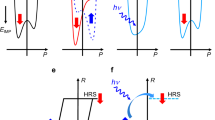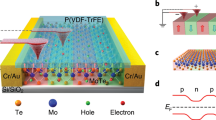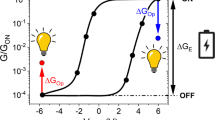Abstract
Materials that are good electrical conductors are not in general optically transparent, yet a combination of high conductivity and transparency is desirable for many emerging opto-electronic applications1,2,3,4,5,6. To this end, various transparent oxides composed of transition or post-transition metals (such as indium tin oxide) are rendered electrically conducting by ion doping1,2,3,4,5,6. But such an approach does not work for the abundant transparent oxides of the main-group metals. Here we demonstrate a process by which the transparent insulating oxide 12CaO·7Al2O3 (refs 7–13) can be converted into an electrical conductor. H- ions are incorporated into the subnanometre-sized cages of the oxide by a thermal treatment in a hydrogen atmosphere; subsequent irradiation of the material with ultraviolet light results in a conductive state that persists after irradiation ceases. The photo-activated material exhibits moderate electrical conductivity (∼0.3 S cm-1) at room temperature, with visible light absorption losses of only one per cent for 200-nm-thick films. We suggest that this concept can be applied to other main-group metal oxides, for the direct optical writing of conducting wires in insulating transparent media and the formation of a high-density optical memory.
This is a preview of subscription content, access via your institution
Access options
Subscribe to this journal
Receive 51 print issues and online access
$199.00 per year
only $3.90 per issue
Buy this article
- Purchase on Springer Link
- Instant access to full article PDF
Prices may be subject to local taxes which are calculated during checkout




Similar content being viewed by others
References
Ginley, D. S. & Bright, C. Transparent conducting oxides. MRS Bull. 25, 15–21 (2000)
Hamberg, I. & Granqvist, C. G. Evaporated Sn-doped In2O3 films: Basic optical properties and applications to energy-efficient windows. J. Appl. Phys. 60, R123–R160 (1986)
Robertson, J. Electronic structure of SnO2, GeO2, PbO2, TeO2 and MgF2 . J. Phys. C 12, 4767–4776 (1979)
Kawazoe, H. et al. P-type electrical conduction in transparent thin films of CuAlO2 . Nature 389, 939–942 (1997)
Kawazoe, H., Yanagi, H., Ueda, K. & Hosono, H. Transparent p-type conducting oxides: Design and fabrication of p-n heterojunctions. MRS Bull. 25, 28–37 (2000)
Thomas, G. Invisible circuit. Nature 389, 907–908 (1997)
Bartl, H. & Scheller, T. Zur Struktur des 12CaO·7Al2O3 . N. Jb. Miner. Mh. 35, 547–552 (1970)
Imlach, J. A., Glasser, L. S. D. & Glasser, F. P. Excess oxygen and the stability of “12CaO·7Al2O3”. Cement Conc. Res. 1, 57–61 (1971)
Jeevaratnam, J., Glasser, F. P. & Glasser, L. S. D. Anion substitution and structure of 12CaO·7Al2O3 . J. Am. Ceram. Soc. 47, 105–106 (1964)
Hosono, H. & Abe, Y. Occurrence of superoxide radical ion in crystalline 12CaO·7Al2O3 prepared via solid-state reaction. Inorg. Chem. 26, 1192–1195 (1987)
Hayashi, K., Hirano, M., Matsuishi, S. & Hosono, H. Microporous crystal 12CaO·7Al2O3 encaging abundant O- radicals. J. Am. Chem. Soc. 124, 738–739 (2002)
Watauchi, S., Tanaka, I., Hayashi, K., Hirano, M. & Hosono, H. Crystal growth of Ca12Al14O33 by the floating zone method. J. Cryst. Growth 237, 496–502 (2002)
Li, Q.-X. et al. Absolute emission current density of O- from 12CaO·7Al2O3 . Appl. Phys. Lett. 80, 4259–4261 (2002)
Henderson, B. & Wertz, J. E. Defects in the alkaline earth oxides. Adv. Phys. 17, 749–855 (1968)
Agullo-Lopez, F., Catlow, C. R. A. & Townsend, P. D. Point Defects in Materials Ch. 5 (Academic, London, 1988)
Williams, R. T. & Friebele, E. J. CRC Handbook of Laser Science and Technology (ed. Weber, M. J.) Part I Vol. III (CRC, Boca Raton, FL, 1986)
Hosono, H., Asada, N. & Abe, Y. Properties and mechanism of photochromism in reduced calcium aluminate glasses. J. Appl. Phys. 67, 2840–2847 (1990)
Giamello, E., Paganini, M. C., Murphy, D. M., Ferrari, A. M. & Pacchioni, G. A. Combined EPR and quantum chemical approach to the structure of surface FS+(H) centres on MgO. J. Phys. Chem. 101, 971–982 (1997)
Oliver, D., Hofmann, P. & Knözinger, E. H2 chemisorption and consecutive uv stimulated surface reactions on nanostructured MgO. Phys. Chem. Chem. Phys. 1, 713–721 (1999)
Hayward, M. A. et al. The hydride anion in an extended transition metal oxide array: LaSrCoO3H0.7 . Science 295, 1882–1884 (2002)
Mott, N. F. & Davis, E. A. Electronic Processes in Non-crystalline Materials, 2nd edn (Oxford Univ. Press, Oxford, 1979)
Weil, J. A., Bolton, J. R. & Wertz, J. E. Electron Paramagnetic Resonance (Wiley, 1994)
Acknowledgements
We thank I. Tanaka and S. Watauchi for growing the single crystals, S. Takeda for NMR measurements, and M. Sadakata, Q.-X. Li and T. Nishioka for TOF-MS measurements.
Author information
Authors and Affiliations
Corresponding author
Ethics declarations
Competing interests
The authors declare that they have no competing financial interests.
Rights and permissions
About this article
Cite this article
Hayashi, K., Matsuishi, S., Kamiya, T. et al. Light-induced conversion of an insulating refractory oxide into a persistent electronic conductor. Nature 419, 462–465 (2002). https://doi.org/10.1038/nature01053
Received:
Accepted:
Issue Date:
DOI: https://doi.org/10.1038/nature01053
This article is cited by
-
Structural, electrical, and optical properties of RxBa1−xSnO3 (R = La, Nd, Sm, Er) transparent thin films
Journal of Materials Science: Materials in Electronics (2023)
-
[Ca24Al28O64]4+:4e− electride ceramic realizes mechanical and electrical transport properties coordinated regulation via composite ZrO2
Journal of Materials Science: Materials in Electronics (2022)
-
Aerogel synthesis of calcium aluminates with varied stoichiometry
Journal of Sol-Gel Science and Technology (2022)
-
The fascinating world of mayenite (Ca12Al14O33) and its derivatives
Rendiconti Lincei. Scienze Fisiche e Naturali (2021)
-
Synthesis, microstructure, multifunctional properties of mayenite Ca12Al14O33 (C12A7) cement and graphene oxide (GO) composites
Scientific Reports (2020)
Comments
By submitting a comment you agree to abide by our Terms and Community Guidelines. If you find something abusive or that does not comply with our terms or guidelines please flag it as inappropriate.



